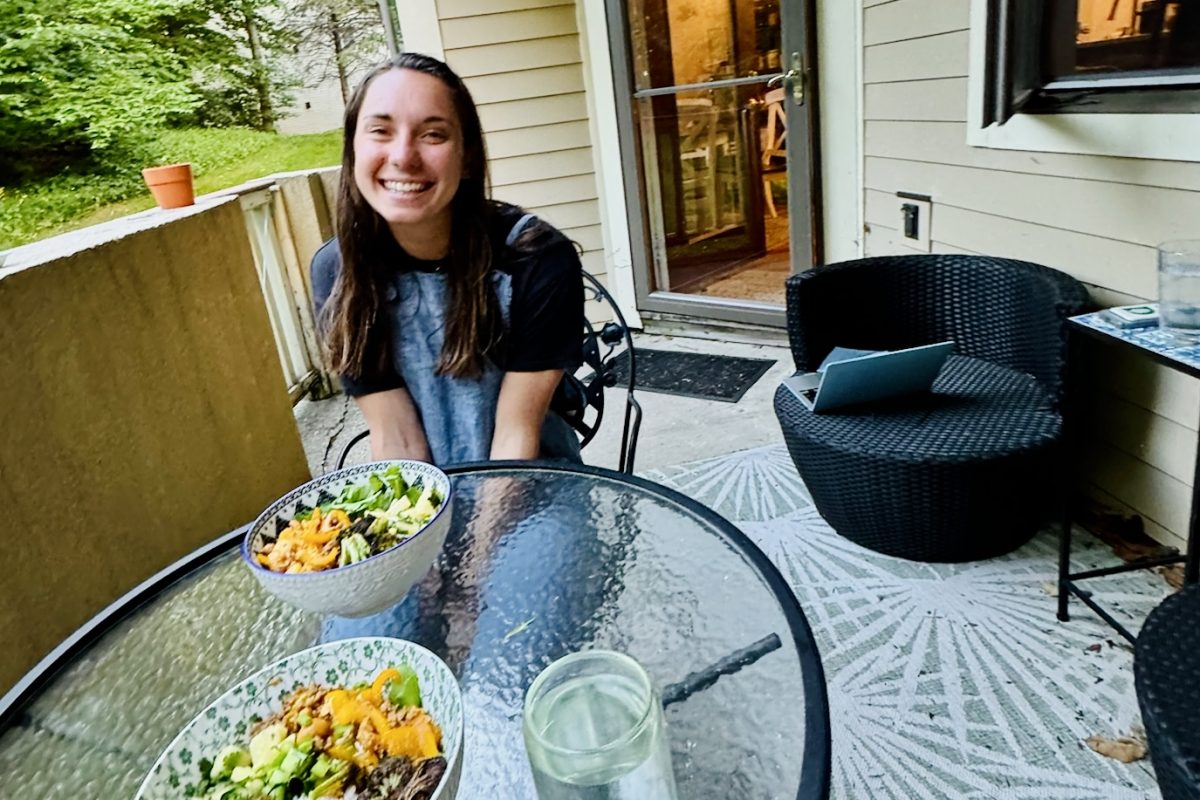Eventual winner David Norris (l) and his APU teammate and second-place finisher Scott Patterson (r) race in the Bird Ridge Hill Climb overlooking Turnagain Arm outside Anchorage, Alaska, in June 2016. (Photo: David Norris)David Norris is having a moment. The 25-year-old native of Fairbanks, Alaska, won his first-ever SuperTour race in Lake Placid in January. The next day, he won his second SuperTour race. In February he won the prestigious American Birkebeiner, taking home more than $10,000 dollars and leaving behind an iconic shot of him exulting as he crossed the finish line. In March, after missing out on qualifying for the Ski Tour Canada, he stayed in Alaska to train and won the Tour of Anchorage, then finished third in a slushy 50-kilometer classic mass start at U.S. Distance Nationals in Vermont.
David Norris earlier this month above Eagle Glacier outside Anchorage, Alaska. (Courtesy photo)For all of these accomplishments, Norris, who skis for Alaska Pacific University (APU), was named the FasterSkier Breakthrough Skiers of the Year among American men. As Norris wrote at the time, “I always want more from myself when any season comes to an end. I don’t think my results have put me in a different position than last year but I’m going into the summer with excitement knowing that some really great results are possible for me.”
That was in April. Norris’s words seem prescient now. Since then, he placed second in the year’s first big mountain run in southcentral Alaska, finishing behind only APU teammate Scott Patterson on a course in the Chugach foothills outside Anchorage that gained a healthy 4,300 vertical feet over 8.5 kilometers (5.3 miles). And earlier this month he traded places with Patterson, edging out his APU teammate for first in the Bird Ridge hill climb mountain run, a race that gains 3,500 vertical feet in less than three miles.
Oh, and Norris also set a new course record at Bird Ridge. The race has been held annually since 1989, and has long been a favorite fitness test for Alaskan skiers. Norris’s 37:04.70 from earlier this month beat everyone on a long line of past champions at Bird Ridge that includes Olympians Holly Brooks, Todd Boonstra, and Bill Spencer, plus former World Cup skiers Nicole DeYong, Trond Flagstad, Brent Knight, Frode Lillefjell, Toby Schwörer, and Rob Whitney.
So what’s Norris’s secret to mountain running success? As Norris modestly notes, “In the last few summers my uphill running has improved tremendously. I am not alone in this as many of my [APU] teammates both on the men’s and women’s side are constantly earning new personal best times. As a result, they regularly share the podium with me in local mountain races.”
Norris also admits, “I don’t specialize or focus on my mountain running performances, but as you can imagine the training for ski racing is great for mountain running results.”
Despite Norris’s announced lack of focus in this area, his results suggest that he knows something about running uphill fast, then translating this to ski speed.
In his own words, here are some of Norris’s top tips for going uphill fast, be it in racing or training:
– Train really hard for ski racing! “Since the major goal is skiing well next winter my training recommendation is to train a lot for skiing and the uphill running will take care of itself. I do believe the longer sustained threshold bounding workouts and distance running sessions in the mountains are especially good preparation for both winter and summer racing.”
– Switching techniques. “For many of the Alaskan mountain races there are steep sections where most racers switch to hiking. Hiking is fine and maybe even better on certain pitches, but forcing yourself back into a running stride as soon as the terrain allows is crucial. It is in some of the gear/tempo changes that I have either been dropped on a bad day or realized an advantage on my competitors. The hiking usually feels more comfortable, but it may not be the fastest.”
– Pacing. “I have discovered through epic explosions that in uphill running I can hardly move up the mountain once I max out or push too hard too early. The pacing for me seems similar to ski racing, but more important because there is no recovery time in an uphill course, in contrast to a rolling ski course. The ideal pace for me is to go out hard, then settle into something that I know is manageable before trying to pick up the pace during the last five or ten minutes of the race. Sometimes I don’t get to choose the pace and I am forced into hanging with my competitors with an early pace that is faster than I believe I can handle. In that case another important aspect to pacing is just running relaxed and keeping your arms loose through the first three quarters of the race.”
As Norris graciously concludes: “I hope some of these tips help you in your next time trial or race. The major tip that I have seen work for myself is to just train a ton for skiing! Make a lot of your training going up big hills – that is, both in easy distance and during intervals. Don’t just hit the flats because you’re supposed to be doing easy distance; take to the hills and just monitor your pace to keep it where you want it.”
David Norris of Alaska Pacific University celebrates his first victory in the American Birkebeiner 52 k freestyle race in February in Hayward, Wis. (Photo: James Netz/American Birkebeiner Ski Foundation)
Gavin Kentch
Gavin Kentch wrote for FasterSkier from 2016–2022. He has a cat named Marit.



